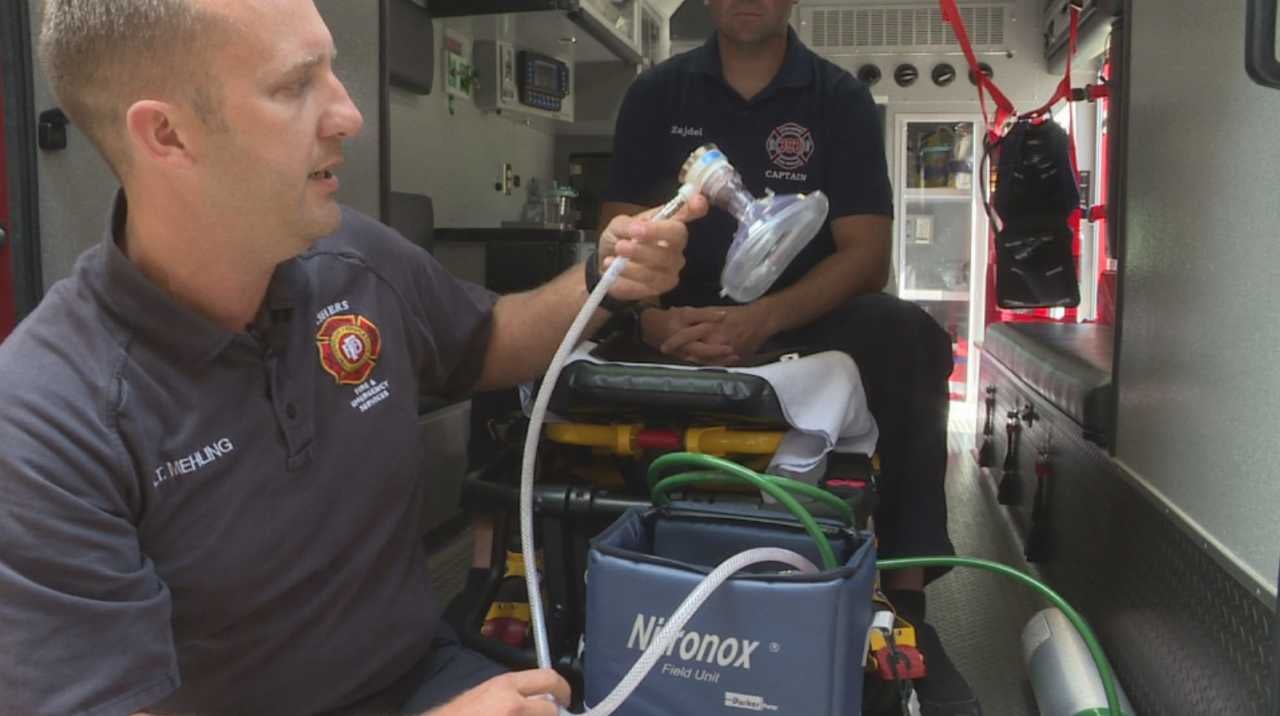Fishers Fire battles opioid epidemic with laughing gas
FISHERS, Ind. (WISH) – The Fishers Fire Department is battling the opioid epidemic in their own backyard by substituting the opioid drug fentanyl with laughing gas in their ambulances.
The department announced the change began Tuesday in all of the emergency medical vehicles in the department.
Laughing gas, or nitrous oxide, is a nonaddictive pain reliever typically used in dental offices. It does not incapacitate a patient but provides temporary pain relief with a self-administered mask.
Capt. John Mehling explained Fishers Fire’s emergency medical technicians will still carry and use fentanyl and other opioids for serious cases but hoped to integrate laughing gas into many of their calls.
“We’re going to use nitrous oxide for simple pain issues so sprains, strains, a couple other minor issues,” the fire captain said. “Anything serious, anything penetrating, any head injuries, we can’t use nitrous oxide for that. We’re going the higher drugs as needed.”
Of the 3,666 EMS runs Fishers Fire completed in 2017, paramedics administered opioid pain relief in 366 cases. Mehling said the department hopes to reduce that number by 66 percent by using laughing gas on certain patients as a first line of relief.
“We’re going to give you the least amount of pain medicine you need. If we need to go up, we can go up. The only thing we can’t do is we can’t start up there and come back down,” he said.
In fact, since the change took place, Fishers paramedics have already administered laughing gas to a patient injured in a trampoline accident with a positive outcome.
“From what we believe, from our research, and now actually having a case study, we believe this is going to be a really positive approach to pain management,” Mehling said.
Many opioid addicts begin with abuse of prescription pain medication. It’s an innocent exposure, according to the fire captain, but can lead to an addiction. By turning first to laughing gas, Fishers emergency medical services may remove the first step in an unnecessary reliance on opioids.
To receive nitrous oxide, patients must be able to hold the mask to their mouths voluntarily and breathe in the 50/50 combination of oxygen and nitrous oxide. The drug takes effect within 2-3 minutes and may allow paramedics to move a patient, assess the larger situation, or prepare for an IV with a stronger opioid painkiller. The nitrous oxide system is portable and runs for a maximum of 40 minutes, reducing potentially toxic leakage to others inside the ambulance.
Mehling said the idea came from a conference Fishers firefighters attended. Their supervisors at St. Vincent Health and the Indiana EMS medical director signed off on the change. The fire captain said Fishers Fire is the first department in the state of Indiana to use laughing gas in ambulances.
Dr. Ed Bartkus, the EMS medical director at IU Health Methodist Hospital in Indianapolis, said he’s pleased to see Fishers EMS try to reduce opioid exposure and expects the program to do well. He explained there are expenses and risks associated with stocking nitrous oxide in ambulances but said it’s a tried and true pain reliever.
“This is not new. One of the seminal articles was in 1979,” the doctor said. “We used it a lot in the 1980s and then it fell out of favor when fentanyl became more available because fentanyl doesn’t cause a drop in blood pressure, so it’s a much easier drug to use. But, we’d like to switch that now, so this makes sense.”
